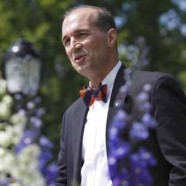
by Todd B. Bland
The Camp — built by my great-grandfather, Hiram Bingham, as a retreat for his wife and seven sons — has been a family gathering place for more than five generations. So many of my childhood “firsts” happened during annual visits to the Camp; so many meaningful memories took root there. There, I learned through stories about my family’s intriguing adventures.
My mother and father, aunts, uncles, great-uncles and great-aunts told stories, but my grandmother’s and grandfather’s were the most powerful. In the telling, the two of them were surrounded by walls crowded with family portraits and historic people, places, events and documents significant to our family and to public history. The most prominent photographs are some of the first photographs ever taken of Machu Picchu in Peru.
The Incas, I learned through my grandparents, did not have a written language. The largest and most advanced pre-Columbian civilization, with its intricate understandings of astronomy, medicine, architecture, agriculture, government and science, did not use writing to share who they were or to preserve their knowledge and culture. The Incas relied on oral tradition to make sure all were aware of their beliefs, and knowledge, and story as a people. Incan “runners,” who ran a hundred miles or more in a day, were entrusted with relaying messages across thousands of miles of Incan civilization. One of the reasons that Machu Picchu had been unknown as a historical treasure was because no historical text documented who built Machu Picchu, what led to their siting and creating this particular settlement, and what its central purpose was.
A child growing up in my family inevitably developed an endless curiosity and appreciation for history. My forebears passed on to the younger people stories of their serving in very public roles over time — as elected leaders, professors, explorers and inventors from one generation to the next. As a result, history was lively and fascinating for me from the start. I came to understand the study of history through personal accounts of family members involved in events that affected not only our family, but also the public at large, nationally and well beyond.
I was fortunate; my grandparents brought to life events and issues from the journey of the Mayflower, through military intelligence in World War II, to John Kennedy’s administration, to pivotal moments in civil rights progress in our country. For 25 years I have told my students that this storytelling inspired me to become a history teacher and ultimately to dedicate my life to education. Though many of my friends’ encounters with history classes had been dry and lifeless, my experience was full of riveting events and exciting detail.
Many characteristics come together in the art of teaching, but certainly one is the ability to tell stories well, stimulating students to do the same. Stories help us to feel, not just know, the impact of the human condition. They help us come to grips with the past, and with one another, in more personal terms. Stories connect us not only with events affecting people all over the world today, but also across time. In telling stories to one another, we fire up our memory bank, make new connections, and stoke the desire to learn more, hear more, share more. All of us, especially those who work with teachers, need to cultivate and honor these person-to-person storytellers. Through them, we come to a new level of understanding, a new launching place for an even greater, always growing reach.



